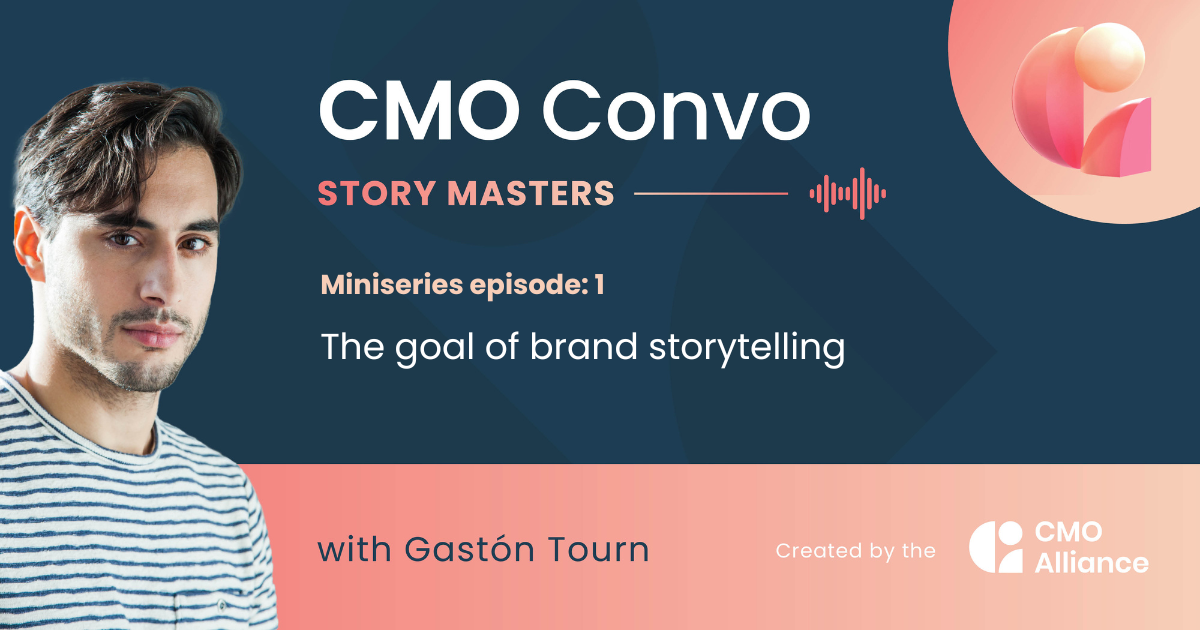Stories are at the very heart of marketing. As a customer marketer part of your responsibilities is to tell your brand's story, your customers', your co-workers', and even your own.
But when it comes to great storytelling techniques, are marketing books the place to go? Definitely not, according to Gastón Tourn, CMO of Curio, who believes that we should be looking to the techniques of great literary figures for advice.
These storytelling techniques have stood the test of time (some of them are thousands of years old), so why shouldn't they be applicable in modern marketing storytelling?
We're taking a look at what should be two of the main goals of your storytelling: defamiliarizing your audience (ostranenie), and maintaining a consistent story they can engage with (willing suspension of disbelief).
Originally an episode of CMO Convo, now available in written form below.
(Editors note: at the time of recording, Gastón was the CMO of Appear Here. He has since moved on to a new role as CMO of Curio).

(re)Introducing Gastón Tourn – CMO and storyteller
Welcome back, Gastón! Could tell us a little bit about who you are, what we'll be talking about today, and why it's so important.
Thanks so much for having me. We're gonna be discussing one of my favorite topics: storytelling. I always wanted to become a fiction writer, but life took me to marketing, which I think is not too far away in terms of writing and creativity. A lot of the skills that apply to fiction writing also apply to my work as a marketer and to the writing I do on the side.
I'm the CMO of Appear Here, the world's largest marketplace for retail spaces. Before Appear Here, I was working at Google in different marketing roles and markets starting in Argentina, where I'm from. I’ve also worked in Brazil, the US, and now the UK. I was also CMO at Badoo Group, which now is called Bumble Group – it's a group of dating apps – and also at Emma, a B2C company. So, I’m both a marketeer and a storyteller.
The importance of storytelling techniques in marketing
You’re the perfect person to be doing this series with for sure. We're going to be taking a look at some traditional and historic literary techniques that people who study literature get pounded over the head with constantly but that don’t come up a lot in marketing circles. Why are we talking about Aristotle and Coleridge and why are they important to marketing?
First of all, I’m a nerd and I love studying literary theory. I love to see how the principles that have been true about storytelling for thousands of years are still true to the marketing that we do nowadays.
Sometimes we get lost in new metrics, platforms, and ways to perform marketing, but in the end, marketing is all about influencing someone to do something. If I had to explain my job to my grandparents who have no clue about tech or marketing, I’d tell them that I’m persuading and influencing people.
When we’re trying to influence people, one thing we need to remember is that human brains are not purely rational. They connect much more with stories than facts and data, and I think that's a good thing. Of course, sometimes it's a bad thing because we make decisions that are not entirely rational, but it's the way that the human brain has always worked – there's always an emotional side.
I think stories are the best way to connect with that emotional side of the human brain, and that’s why storytelling techniques are so relevant for marketers. They’re the key to influencing and persuading.
We're going to be talking about some very old concepts dating back to Ancient Greek times, as well as some relatively recent ideas from 18th and 19th-century authors. The principles of storytelling that these writers and literary critics came up with are still relevant in how we tell stories today in fiction and film.
The mediums might have changed but how we tell stories hasn't changed much, and it's the same with marketing. New technologies might come out, but the building blocks of what makes a great story have stayed the same.
Definitely. Some principles have been true for thousands of years, and there's so much we can learn – not just marketers, but anyone in business. Storytelling is a critical skill for fundraising, presenting to boards of investors, and negotiating a promotion too.
Sometimes we just rely on business sources or books to understand how to persuade or influence, but the people who have done this really well for a long time are writers and storytellers, and I think literary critics and people who have studied the art of storytelling can give us a lot of insights on how to make our stories so compelling that people can’t resist watching or reading them.
We're not going to get too nerdy – don't worry. We're just going to be sharing some concepts that you can then apply to your own marketing to make your stories much more interesting. These are concepts that I apply to my work every day, and they really help to elevate whatever creative I am producing.

Ostranenie or the art of defamiliarization
We’re going to be looking at two storytelling fundamentals today. Gastón, do you want to introduce the first one?
Yes, the first one has a very difficult name and it comes from the Russian formalists, a very important school of literary theory in the early 20th century. It's called ostranenie, which means estrangement or defamiliarization. It’s all about making the familiar unfamiliar or the unfamiliar familiar.
Ostranenie captures people's attention, and that's what marketing tries to do as well. Our everyday lives sometimes can be quite monotonous and repetitive, and I think that’s why making the familiar unfamiliar or vice versa is so appealing. It presents a new way of looking at the things we see every day.
Now, I'm from Latin America, so of course I'm biased, but I think magical realism is one of the most interesting literary schools and a great example of the power of defamiliarization. It brings magical elements to reality, telling a story that could be real, but with some unfamiliar aspects that distort it so you're not really sure what's going on.
One of the most important books from that literary school is 100 Years of Solitude by García Márquez, an amazing novel that I recommend every marketeer to read. It’s probably one of the best examples of how to tell a truly compelling story.
One thing that García Márquez does brilliantly is use familiar elements in a very unfamiliar way. In 100 Years of Solitude, it starts to rain and it doesn't stop for five years. It's weird to imagine living in a world where the rain doesn't stop for five years, but at the same time it’s not completely impossible, and it’s interesting to see how something as familiar as rain could affect everyday life in a really strange way.
There are so many other examples. Speaking of rain, a movie I love that uses a very similar resource is Magnolia. Again, it starts to rain, but it rains frogs, so you have a world where rather than the rain we're used to, suddenly you have frogs destroying houses and cars.
That's what ostranenie is in a nutshell – making something that is quite usual look unfamiliar because that captures people's attention. That makes people realize, “Wow, the world I live in is not that common; it's actually quite uncommon,” and think it brings back that magic to everyday life.
And it's not just strangeness for strangeness’ sake. Particularly with magical realism, the alterations they make to reality are about holding up a mirror to make you think about your current reality differently.
A great example from the world of advertising and marketing is car adverts. Cars are simply machines, but TV car ads don’t talk about the mechanics of it; they talk about the feeling that comes with being in the car; they talk about the destinations you can go to. It's not about the practicalities of the object; it's about the potential new ways of looking at the world provided by that by the car.
Yes, marketing stories cannot just illustrate what the product does; they need to elevate the product experience. A marketing advert that just illustrates in very practical terms what a product does is going to have some effectiveness, but it’s not going to tell a compelling story about the brand and so it’s not going to build the brand.
If you just show the product and how it works, your advert is going to be quite dull, but if you defamiliarize it and you show that experience, it captures people's imagination and creates a much stronger emotional connection with the product.
What are some real-world examples of this in practice? I mentioned car adverts in general, but let's talk about some specific campaigns or brands that are doing this really well.
One of my favorite ones is from Google Analytics, a product that a lot of marketers use in their everyday lives. We're probably all a bit bored of using just Google Analytics and hearing about bounce rates and conversion rates. This campaign is called Google Analytics in Real Life, and it defamiliarizes some of those metrics by putting them into the real world. For example, what would bounce rate mean in a real-life supermarket?
It almost parodies what would happen if those metrics showed up in a real store, and it makes it so visible that a lot of our online experiences are just really bad, for example, when you're trying to check out on a website, and it asks you for 10,000 different pieces of information, and then when you click on “buy”, sorry, the connection is not working. It brings all these elements to an interaction with a cashier in a supermarket, which makes it really funny.
That's one of my favorite examples just because I think Google Analytics can be quite dry as a product, but when you see this campaign, you start to understand how those metrics have a massive impact on the customer experience. They do that just by defamiliarizing using some of those online metrics, and that really captures your attention and makes you aware of what may be going wrong in your online customer experience.

Being funny is quite a difficult thing, but parody and satire can be a really great way to think about how to apply defamiliarization.
Absolutely. Most good stories aren’t entirely literal. Usually, there is some level of irony or metaphor that makes the story a bit more interesting. If we are literal, people kind of switch off because you're giving them facts without involving them in the story.
In one of the most beautiful parts of Aristotle’s Poetics, he says whenever it comes to an argument, if you tell people the conclusion right away and let them infer the premise, they're going to be much more interested in whatever you have to say. That’s because you’re making them feel smart.
If you go the logical way – premise A, premise B, then conclusion, it’s a bit boring and almost patronizing. You're acting like an old-school teacher, which is what more product-led ads do – give you the premise, then tell you that you should buy this product.
If you do it the other way around and start with the conclusion, if you use a more metaphorical tone or you use some level of irony, it just makes people much more compelled and it makes them feel smart. That's what irony does. We’re complicit in something that only you and I know, and that makes me feel closer to you, but it also makes me feel smart because I inferred what you were trying to say.
A great example of this comes from one of my favorite adverts of all time – the Guinness surfer advert. It's all about a surfer in Hawaii waiting for his entire life for the perfect wave to come along, and finally it does. He rides the wave while all these dramatic drums are pounding, and at the end just cuts to a pint of Guinness and the slogan, “Good things come to those who wait.”
At no point did they say anything as simple as “Drink Guinness – you'll feel as though you just caught the best wave of your life.” Instead, it allows the viewer to draw their own connections between the story and a pint of Guinness. People who like Guinness and who know that you have to wait for the pint to settle recognize that anticipation. That builds more of an emotional connection between you and the advert and the product.
It's fantastic and it's one of the reasons I first got into marketing – because I wanted to create stuff like that. It tells an effective story that is unfamiliar – I doubt there's a lot of crossover between Hawaiian surfers and Guinness drinkers, particularly in the UK where the ad was first shown – but you can draw the connection between these scenarios in a way that makes sense. I think that's a great application of ostranenie in marketing.
Let's talk about how you're applying these principles in your marketing work, Gastón.
The campaign that comes to mind is Save The Street. It’s a campaign that I led during the pandemic. For those of you who don't know, Appear Here connects mostly independent brands and independent stores with spaces to make their ideas happen.
During the pandemic, a lot of these independent brands were really struggling. Big retailers got a lot of government help, but independent retailers didn't. Some of those big retailers even returned the money because they didn’t need the support, whereas independent retailers needed it the most. That was especially sad because they’re some of the most important pillars of their local communities.
During that time, to support the independent retailer community, we decided to amplify their voices and bring their demands back to the government, so we started working on the Save the Street campaign alongside a petition to the government.
We got a lot of support for it. Particularly when it comes to business rates, there was a lot of support from the government. The Minister for Small Business in the UK mentioned the Save The Street campaign when he announced new measures for independent retailers. It was a very successful way of helping independent retailers to survive during a pandemic.
For the campaign creatives, we didn't go full political manifesto. We tried to defamiliarize some of these communications and make them much more interesting and compelling for someone who perhaps doesn't care about independent stores or who doesn't care about high streets as much as we do.
With this in mind, we worked with a poet called Charly Cox to create a poem for our high streets, and it was a great way of defamiliarizing how we interact with high streets and the meaning high streets have for people all across the country. One of my favorite lines from that poem talks about the baristas that know your name before you say hello, which I think is a quite beautiful way of showing how we build community and relationships in those high streets.
There were some beautiful moments in that poem that were not typical of a political campaign, but they defamiliarized our high streets and brought new attention to why they’re so important to build community.

Willing suspension of disbelief
Onto the next literary technique: willing suspension of disbelief. This is a phrase coined by one of my favorite poets of all time, Samuel Taylor Coleridge, in Biographia Literaria, which sounds very, very high-minded and fancy because that's how Coleridge thought. It's a term that I think gets thrown around a lot, but at its core, willing suspension of disbelief is about noticing the differences that don't fit the inherent logic of the story.
An example of this would be an animal suddenly speaking when the story hadn't established that animals could speak in the story. You've got all these human characters, and suddenly, a cat pops up out of nowhere and starts talking to the characters. If you haven't established any reason behind why that cat can talk, it can pull people out of the story.
If you've established that animals can talk right from the beginning you don’t have that problem. An example of that would be Fantastic Mr. Fox by Roald Dahl, which establishes right at the beginning that animals act pretty similar to humans. If they had normal foxes at the beginning that suddenly started acting like humans halfway through the story, you'd be pulled right out of it, and you wouldn't understand what was going on.
The best way to think about how this can apply in marketing is in terms of consistency within the brand story you’re telling. If you don't have some kind of inherent logic throughout the brand story and the experience that the customer is having, they'll notice that inconsistency and that’s gonna pull them out of their connection with the story you're trying to tell.
That's my perception of it in a nutshell. Gastón, what are your thoughts?
I completely agree. If something looks too weird or unreal, people are going to notice it, they're going to be like, “What? This doesn't make any sense,” and they're going to switch off. So you want to make sure that in all your communications you're building a world that seems real. That doesn't mean that you can’t use any magical or fictional elements, but whatever kind of weirdness you apply needs to be believable within the context of the story.
I think a lot of product placements do this really badly. Everyone was talking about the Peloton placement new series of Sex and the City and how bad it was because Mr. Big was just training on his Peloton and then suddenly he died.
That's just one example. I don't want to talk negatively about Peloton because they helped a lot of people through the pandemic, but I think a lot of those product placements are just so unbelievable that people are immediately aware that what they’re watching is just fiction and, worse, maybe the whole series is a way of making money out of product placements rather than telling a compelling story.
Product placements are an example of what happens when you don't follow the suspension of disbelief principle. You can do product placement in a really organic and natural way, and if you do that you're suspending that feeling of disbelief, but I would say most of them get it wrong.
The technical term for breaking that suspension of disbelief is deus ex machina – sorry for bringing all these complex terms. Deus ex machina originally comes from theatrical plays and stories that the writers didn't know how to finish. The plot would end up so complex that the only way to get to a conclusion was for God (deus in Latin) to come and finish everything by, say, killing everyone. From the audience’s perspective, that came out of nowhere.
For sure. I think product placements, particularly celebrity endorsements are a great example of that. Seeing very wealthy people talking about using an at-home box dye when they clearly have a huge team of stylists around them is jarring.
You don't want people who don't know how to use your product or have never even seen your product saying, “This is great! You should use it!” There's no logical consistency to why they would be using that product in the first place.
Completely. You're using a concept that marketers love, which is consistency, right? We love to say brands need to be consistent. I wrote an op-ed for Adweek because I got a bit bored of the word consistency. It was at a time when I was working in corporate and pretty much every idea I wanted to present to leadership was getting rejected because it “wasn’t consistent.” It seemed like everyone was letting consistency get in the way of exciting work.
It kind of went around in a circle for me. In the beginning, I was like, “I hate consistency!” But then I realized consistency is super important. The problem is that a lot of people think that consistency means repetition. You see this especially if you work for a corporate brand – whenever you try to spice up the language or change a few things up, you're told “No, that's not consistent. We always use the same words,” but it ends up sounding so robotic.
So what I argue in my op-ed is that consistency doesn't mean repetition. Consistency is about building a world where the brand feels authentic. I don't think you need to be consistent when it comes to the language you use.
Where you need to be consistent is with the values that your brand stands for, and I think that's quite different. For example, if you're a brand like Bumble and you stand for gender equality, you don't need to use the same words to express gender equality, but you definitely need to be consistent with that value. That consistency builds trust.
If you have a friend that’s always repeating the same words all the time, you're gonna think “Oh my God, my friend’s a robot!” And it’s the same with a brand. In that human relationship, what you expect when it comes to consistency is the person just being authentic and staying true to their values.
If someone one day says X and then the next day says the opposite, you're not going to trust that person because you don’t know where they stand. Of course, values can evolve over time, but if they dramatically change overnight, that makes me wonder if I can trust this person. It’s the same with brands: consistency means making sure that you stand for some values and you stay true to those values. That's what we need to focus on.
I think one of the best recent examples of brand consistency is Patagonia. Giving the company away to help fight climate change – that's an example of consistency with their brand values. It’s not repeating the same words – I don't care about what words Patagonia uses in every single ad. What I care about is that they’re consistently staying true to the same values they have defended from day one.
How are you applying these concepts in your role as a CMO? Are there any examples that you can pick apart?
Some of our customers at Appear Here have such amazing stories that sometimes it almost seems unreal that they went through so much and managed to achieve what they achieved. In my storytelling, I try to make sure I don’t put too much focus on things that are so extraordinary that viewers might find them unbelievable.
As a recent example, we have an amazing customer called Steve. He grew up in South London, he had some difficult personal moments, and he became homeless at the age of 16. He was not enjoying the food he was getting in hostels, so he learned how to cook by watching YouTube videos.
From there, he became the chef of some amazing restaurants, including a Michelin-starred restaurant on the coast of England. He even appeared on BBC2’s The Chef’s Brigade. His dream was always to launch his own restaurant, but a lot of landlords were not giving him that opportunity because of a lack of economic resources.
At Appear Here, because we are all about giving opportunities to the people we serve and who have great ideas, we helped him launch his first restaurant in South London, where he's from. It’s called Sharkbait & Swim. You should check it out if you're in London. It’s an amazing seafood restaurant in Deptford.
That story is almost unreal, right? When you hear it, you're like, “Woah! How did he go from here to here?” It's just such an amazing story, and Steve is such an amazing human being. It’s almost hard to believe that someone really could go from nowhere to such an exciting place in life.
When telling that story, I have always been very conscious of making sure the journey felt authentic to the character. Steve was always a chef. He went through some hardship that made him unfortunately become homeless, but food has always been at the heart of what he loves.
I think that was really important to the suspension of disbelief. If you have a story where somebody goes from nowhere to being incredibly successful, but there's nothing in that original place that can explain where the story is going, people start questioning the reality of that story.
Defamiliarization + suspension of disbelief = storytelling gold
It seems like the concepts we’ve been discussing today are almost antithetical to each other, but they're not, are they? You can have defamiliarization and this sort of logical consistency within the same story at the same time.
Ostranenie and suspension of disbelief are incredibly important, and they're not opposite ways of telling the story. Ostranenie makes the unfamiliar look so familiar that you start believing that it could happen. Similarly, when you make the familiar unfamiliar, you do need to do it believably. That movement between familiar, unfamiliar, and making sure that the world we're building makes sense makes stories compelling and makes us want to hear them.
In the end, we listen to stories because we want to learn something about our lives and how we can deal with the complexity of the world. If it's too far-fetched or we don't feel that we’re learning anything, we’ll probably stop listening, so you want to make sure there is something that people can relate to in your story and that it seems real
Excellent. There's loads more to explore on the subject, but hopefully this has been a nice little introduction to these concepts for our audience. In our next conversation, we're going to be talking more about how you go about constructing a story. We're gonna dig into the four-act structure, the importance of change within a story, and what a scene means within a story. I'm very excited to have that conversation with you, Gastón.
Thank you so much.
Looking for more ways to improve your storytelling skills as a marketer? Don't miss our Storytelling Certified: Masters course.
Got stories to share with marketing leaders? Tell your story, and discover some others on the Customer Marketing Alliance Community Slack channel.






